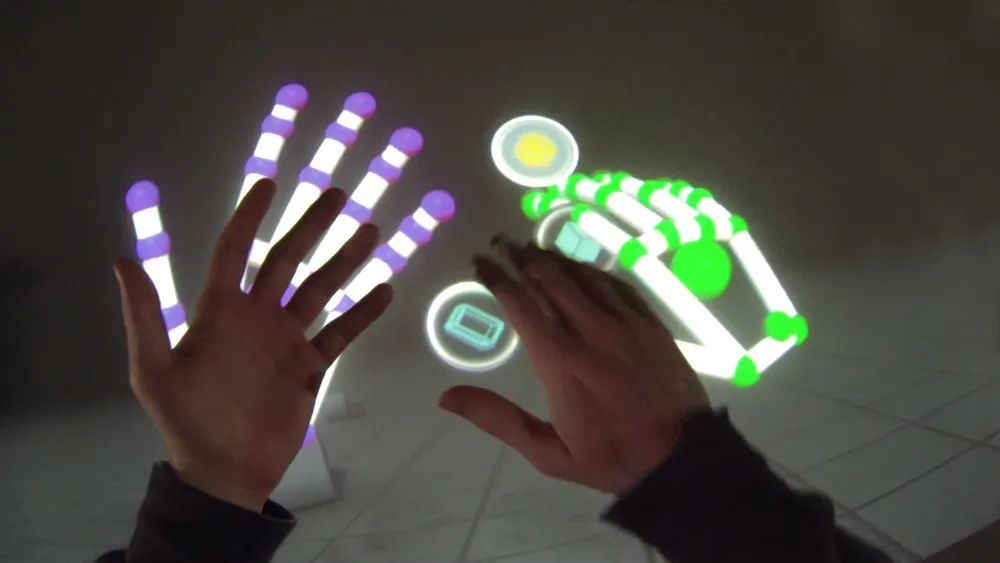Last September we reported on the fact that Qualcomm was launching their own VR development kit with the ability to deliver standalone VR. What made the VR 820 so compelling was that it had 6-DoF tracking as well as integrated compute (Snapdragon 820) which was on par with all the latest flagship phones. It even had support for eye tracking, which we now know was through a partnership with none other than SMI. However, there was one thing that was missing, hand tracking. In fact, Intel was already demoing hand tracking this year at CES with their Project Alloy prototype.
Anyone that has used mobile VR knows that controllers are nice, but unless you can ‘see’ your hands and interact with your surroundings with your hands, the immersion is lost. HTC and Valve do this with their Vive controllers that are super low latency and extremely accurate and Oculus does this with their touch controllers and their extremely natural ergonomics. When it comes to mobile, in many cases you’re either stuck with a Bluetooth gamepad on Samsung or a controller like the Daydream controller which simply put isn’t good enough. Thankfully, the team at Leap Motion have been working tirelessly to deliver hand tracking and late last year launched their much more compact hand tracking solution specifically aimed at mobile form factors.
Now that their technology has been miniaturized, it can be integrated into platforms. One such platform that’s launching at MWC and GDC (since both shows are happening simultaneously), is Qualcomm’s new Snapdragon 835 VR development kit. This new Snapdragon 835 VR development kit features a 2560×1440 AMOLED display, 6DoF tracking, eye tracking, foveated rendering and many other performance and power saving features. This system is essentially an upgrade over the Snapdragon 820 developer kit that Qualcomm launched at IFA 2016. The real improvements are increased performance, power savings and support for Leap Motion. While we don’t quite yet know the performance of the Snapdragon 835, the expectations are that it will be quite a bit faster on the GPU than the Snapdragon 820, which is a blessing for VR. The Snapdragon 835 VRDK is expected to be available in Q2 through the Qualcomm Developer Network. This device is really designed to help developers optimize their apps for the Snapdragon 835 HMDs that are due out in the second half of this year.
In addition to announcing the partnership and support of Leap Motion and a new VR development kit based on Snapdragon 835, Qualcomm is also announcing an HMD accelerator program. This program is specifically aimed at accelerating the time to market for HMD manufacturers, which has been an issue for some companies. The program is designed to help HMD manufacturers reduce their engineering costs and time to market so that they can seed the market with these HMDs faster. Part of this program utilizes the newly announced Snapdragon 835 VR HMD and will connect OEMs with ODMs like Thundercomm or Goertek, the two leading HMD ODMs in the world. The program is designed to help OEMs modify the reference Snapdragon 835 VR HMD and enable pre-optimized features like SMI’s eye-tracking and Leap Motion’s hand tracking.

These three announcements are very closely intertwined and show where mobile VR and more specifically standalone VR is going. Mobile VR itself will still benefit from the advances that result from these new developments, however standalone VR is currently the focus of this platform. The interesting thing about the mobile industry and players like Qualcomm is that they can iterate so much more quickly than their PC counterparts that we are seeing mobile HMD feature sets leapfrog PC. The fact that the Snapdragon 835 VR platform will support both eye tracking and hand tracking is huge because both of those are natural interfaces. Combining hand tracking, eye tracking and voice recognition into a single device means that a user can naturally interface with their VR HMD without ever needing to touch anything. Ultimately, hands free VR is the holy grail and I think that Qualcomm has brought us one step closer to that reality.
Disclosure: My firm, Moor Insights & Strategy, like all research and analyst firms, provides or has provided research, analysis, advising, and/or consulting to many high-tech companies in the industry, including Google, Intel, Qualcomm and Samsung cited or related to this article. I do not hold any equity positions with any companies cited in this column.




























